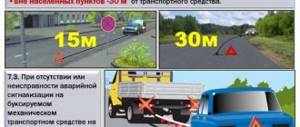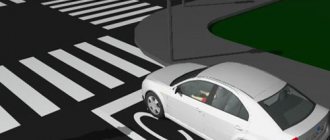What are mud flaps for?
Mud flaps on a car are special linings located under the rear and sometimes under the front wheel arches. Typically, such a part is made of dense rubber, although a lightweight, plastic version of the product is often used on passenger cars. The mudguard serves solely to protect vehicles behind from getting stones and other debris into the windshield.
It is important to know! At high speeds, gravel, crushed stone and other hard rocks, of which there are many on the road surface, can not only damage the car, but also lead to more serious consequences, such as injury or even death to a person. In order to prevent such troubles, the administrative code introduces fines for driving without mudguards in 2021 for all categories of drivers.
Why, when buying a new car, you don’t need to install mud flaps
Car mudguards, as you know, come in front and rear. The purpose of the former is to protect your dear car (mainly the bottom) from dirt, small gravel, reagents and other road debris. The latter are also needed to ensure the safety of vehicles coming from behind: so that all this nasty stuff doesn’t fly into the windshield from under your wheels.
In addition, mud flaps are divided into universal and individual. As you can guess from the name, universal ones easily “fit” into the design of any car. Another question is that they look “collective farm” on some cars. Individual ones are produced by the manufacturer for a specific model. They do not spoil the appearance of the vehicle, but, as a rule, they are significantly more expensive.
Since rear mud flaps affect road safety, the need for their use is specified in the traffic regulations. For ignoring this requirement, you can even run into a fine: according to Article 12.5 of the Code of Administrative Offenses, traffic police officers who catch a driver committing an offense can either conduct an educational conversation with him or write a report for 500 rubles.
It is important to remember that the traffic rules only talk about rear mudguards and, moreover, those provided for by the design. So, if the dealer gave you a new car without a protective device, then the traffic cops have no right to fine you. This means that the manufacturer solved the problem of dirt flying from the road in a different way, by adjusting the shape of the wing.
But, let’s say, a traffic police officer picked on the lack of mudguards on your car. The easiest way to avoid a fine in this case is to show the meticulous law enforcement officer a valid inspection ticket. Without the notorious “rubber bands” provided by the design, you simply would not have been given the “green light”.
Legislation regarding the presence of mud flaps on cars
According to the legislation of the Russian Federation (namely, Article 7.5 of the Traffic Regulations), the mudguard can be made of rubber or soft plastic, capable of holding back not only dirt, sand and water, but also stones flying at high speed from under the wheels. The absence of this protective element does not entail a fine only in two separate cases:
- Mud flaps are installed only on the rear pair of wheels (on the front axle, pads are optional);
- The mentioned part is not provided in the factory design of the vehicle.
And if everything is clear with the first situation, then the second circumstance causes a lot of controversy between drivers and traffic police inspectors.
The mudguard itself must have a cast form (if it consists of two or more parts, then no gaps are allowed between them), and fully comply with GOST 52422 of 2005. It includes the following items:
- The lower part of the protective part can be located at a distance of no more than 200 mm from the asphalt surface;
- The inside of the splash guard must be equipped with a special device for retaining water;
- The angle of inclination of the pad cannot exceed 10 degrees against the vehicle;
- The width of the protective part must correspond to the width of the wheel or extend beyond it (no more than 200 mm).
At the same time, State Traffic Inspectorate employees can fine the driver both for the complete absence of mud flaps and for their non-compliance with GOST. But the amount of the financial penalty in both cases will be the same, since the Code of Administrative Offenses does not provide for a separate article for failure to comply with uniform standards.
How to install it yourself
There is no point in considering the installation of original mudguards, since the shields sit in the original places. In addition, the shields often come with instructions that explain the purpose and method of installing the fasteners.
To install universal mudguards you will need:
- Phillips screwdriver for screwing in self-tapping screws;
- a stationery knife, since universal products do not always perfectly fit the shape of the locker and body;
- rags for cleaning the installation site;
- a sharp object for marking holes.
Work algorithm for self-installation:
- clean the intended installation site from dirt;
- Attach the mudguard to the fender in the way it will subsequently be secured. If necessary, trim the shield to the shape of the fender and sills. If the lockers on your car are attached using self-tapping screws, mark the location of the holes on the mudguard so that later you can screw the screws in there;
- Screw in at least 2 self-tapping screws on the outside and one self-tapping screw that will secure the inside of the mudguard to the fender liner (they can also be tightened with a bolt and nut).
It is futile to try to describe the installation details for each car model. For example, on some cars the fender liners are attached with massive clips, and therefore the mudguard screws can be screwed directly into them, while preserving the metal of the fender. There are no problems at all with installing the rear mudguards, since the screws will not damage the plastic bumper.
Grounds for imposing a fine
According to the Code of Administrative Offenses, an employee of the State Traffic Inspectorate can issue a fine to the driver for the absence of mud flaps on a car in 2021 on only two grounds:
- Visual non-compliance of the part with the established GOST (the pad is too narrow, short, or there are holes on it that appeared as a result of wear);
- Virtual absence of mudguard.
At the same time, the driver will not be able to appeal the traffic police decision, citing the fact that the part fell off when the car was last used. After all, the Code of Administrative Offenses strictly prohibits driving a car without mudguards. If they break down, the car owner must replace them on the spot: independently or by calling a specialist.
The need to install mud flaps on a car
The installation of mud flaps on cars is not always carried out by the manufacturer. Manufacturers often use small plastic flaps on the front of the sill or rear bumper, partially cutting off the flow of dirt from under the wheels.
Dealership centers offer installation of additional elements for an additional fee; owners of used cars can install the screens themselves in a garage.
Amount of fine for lack of mudguards
In accordance with Art. 12.5 of the Administrative Code, driving without mudguards in 2021 will be subject to a fine of 500 rubles (for both motorcycles and four-wheeled vehicles of class B, C, D). And even though a violation of this kind falls into the light category, the driver is not entitled to a warning for it.
In practice, State Traffic Inspectorate employees rarely issue orders under Art. 12.5 of the Code of Administrative Offences, limited to only an oral remark. But repeated ignoring of the mentioned article in a short period of time can increase the likelihood of liability for the lack of mudguards.
If a new vehicle doesn’t have mudguards, is it necessary to install them so that I don’t get fined?
People who purchase modern cars often wonder whether they need to install mud flaps on them. Quite a long period has passed since everyone drove vehicles on which this part was present in a rubber version straight from the factory. Today you can hardly find mud flaps on new vehicles anywhere. Moreover, now even many models do not include mountings for them at all. Car owners can only build something on their own or resort to the developments of other companies, which, due to their lack of versatility, are not suitable for everyone.
The main purpose of mud flaps is to maintain visibility for passing cars, which can easily be disrupted due to splashes flying out from under the wheels. That is, this detail can be classified as a safety element. Why did car manufacturers suddenly decide to neglect the safety of car owners, because it is one thing to save on installing plugs, stops and other little things, and another thing to save on mud flaps, which play an important role in safety.
It is clear that no one will allow cars that do not meet the standards to be sold. There have already been similar cases with the VAZ 21099, when its rear part was strongly raised and because of this the wheels stuck out. Now think about what it would be like to drive behind him on a very snowy and windy day. Now imagine that the Infiniti FX45 is driving in front of you, the rear wheels of which are set much deeper for the sake of design and capacity.
So, Russian laws and regulations say nothing about mud flaps on passenger cars. However, the definition of “splash protection system” exists. The guest standards say that the location of the wheel axle should be level with the lower edge of the vehicle body, as well as how long the overhang should be and at what angle of inclination. If, when choosing a car to buy, you do not find mudguards, then during its manufacture the arch was made in accordance with all the requirements stipulated by GOST.
At the same time, many car owners who follow the release of new cars have noticed that front mudguards are now installed on cars, but not rear ones. This is all set at the discretion of the manufacturer. Some people do this to protect the sills from sandblasting on vehicles with front-wheel drive. Most often, there are no mudguards on the rear axles due to the financial benefit of the manufacturer.
As for stones flying out and falling from under the wheels into the front windows of a vehicle, there are many cases where even this special protection did not save. For example, once on a forum a car owner wrote how he was hit in the windshield by a stone from a car in front, despite the fact that the arch was quite low and the wheels themselves were set deep, and in addition to this there were also mud flaps. Therefore, they are far from a panacea for stones.
How to avoid a fine
If you were stopped by a traffic police officer for not wearing mud flaps, but he did not have time to draw up a report yet, then you have every chance to avoid this procedure by citing the following arguments:
- Protective pads are not provided on the vehicle by the manufacturer (mudguards were not installed on most domestic vehicles. Moreover, the inspector must prove that the mentioned part belongs to the design of the vehicle. Otherwise, he will not be able to fine the driver under Article 12.5 of the Administrative Code);
- The mudguard fell off during the last time the car was used and at the moment you are moving towards a repair shop in order to fix the problem (although according to the rules this circumstance is equivalent to a violation, in practice inspectors can take pity on the car owner and let him go, making only a verbal remark);
- If a traffic police officer insists on issuing a fine for the lack of mud flaps, under no circumstances agree with the punishment received, and demand from the police a blank form for drawing up an explanatory note (in the last document it is necessary to mention that there were no problems when leaving the parking lot. This will help you in further challenging the protocol in court).
Attention! Art. 12.5 of the Administrative Code is not considered serious, which is why you can evade responsibility for non-compliance even through a banal conversation with representatives of the traffic police. But if a conflict situation arises with patrol officers, the driver will be able to defend his rights in court.
Is it possible to challenge the punishment?
Having received a decision on violation of paragraph 7.5 of the traffic rules, the driver can appeal the punishment imposed by the inspector in court. To do this, it is enough for him to refer to the following facts:
- The State Traffic Inspectorate employees do not have a certificate of non-compliance with the design of the car (this document is the only legal confirmation that mud flaps must be installed on a specific car without fail);
- Lack of evidence (if traffic police do not have time to record the offense itself and the culprit who was driving the vehicle at the time of its malfunction, the resolution will be automatically invalidated);
- Drawing up a protocol, ignoring the explanatory note (if the car owner puts forward a version that the protective overlay was present during the period of leaving the parking lot, then in court, most likely, he will be acquitted).
You can also challenge the issue of the mudguards not complying with the unified GOST, reclassifying the case as an “unreasonable stop”, for which the inspectors themselves will bear the punishment.
We found out what the fine is for not having mudguards in 2019, and how you can avoid liability without going beyond the law. In conclusion, it remains to add that in most cases, the issue of violation of paragraph 7.5 of these rules is resolved on the spot, through a banal conversation with traffic police officers. After all, it is quite difficult to prove the driver’s guilt in this case, and challenging the protocol will not be difficult.











